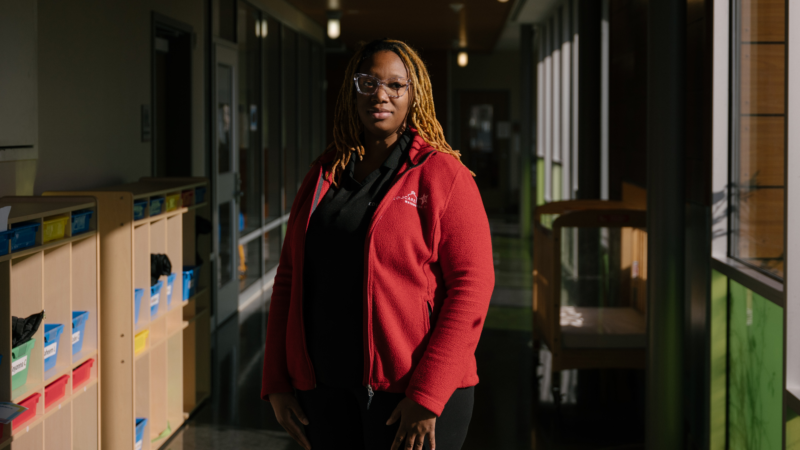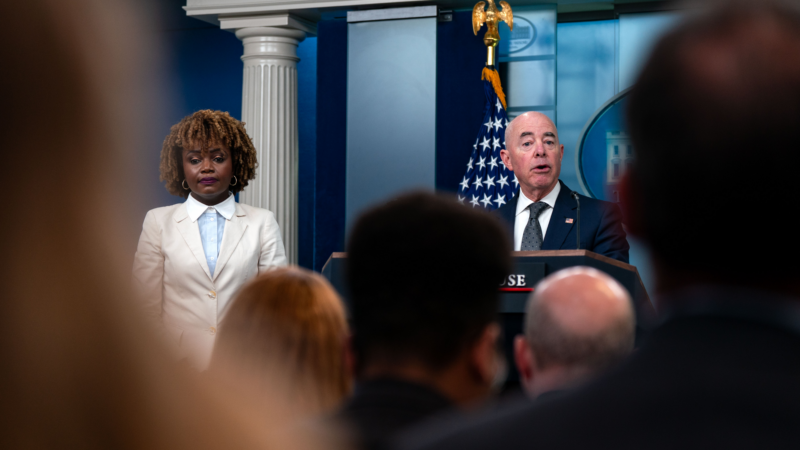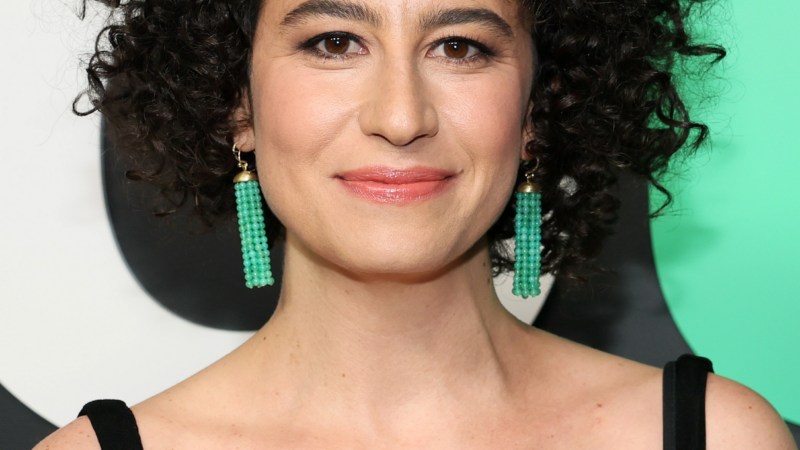How D.C. tackled a child care crunch through a tax hike on the rich
WASHINGTON, D.C. — When Boniece Gillis first heard rumblings that child care workers across the city might be getting some kind of significant pay bump, she tried to keep her excitement in check.
“I was like, I’ll believe it when it comes,” says Gillis, an assistant teacher with Educare DC who was making about $18 an hour at the time, a couple dollars more than D.C.’s minimum wage.
In the fall of 2022, the raises did come. Two years on, the money has proved transformational.
Gillis is one of roughly 4,000 child care workers in the nation’s capital who have benefited from a fund established through a tax hike on city residents earning more than $250,000 a year.
The concept behind the Early Childhood Educator Pay Equity Fund is simple: to bring the wages of child care workers, who are among the lowest-paid workers in the U.S., in line with those of public school teachers.
Since the fund’s establishment, the District of Columbia’s child care workers have seen their wages rise by just over $10,000 a year, on average, setting off what researchers describe as a chain reaction: With some level of financial stability, teachers have been far less likely to quit. Reduced turnover means child care centers and home-based providers are no longer struggling to recruit and train new employees. Meanwhile, families are finding there are now more child care slots. And with more experienced teachers staying on the job, children are receiving better care.
“We know now what a big change it has brought to people’s lives,” says Erica Greenberg, a senior fellow with the Urban Institute and one of a number of researchers studying the impact of the fund. “It was long overdue.”
A 23% return on investment
The gains are not just anecdotal. Two years after the first payments went out, researchers are finding that the initiative is yielding quantifiable wins.
Owen Schochet, a researcher with Mathematica, calculated that the Pay Equity Fund boosted child care employment across Washington, D.C., by nearly 7%, or 219 additional teachers.
Working with economist Clive Belfield of Queens College, City University of New York, Schochet compared the cost of the program — an estimated $54 million in 2023 — with the value of the benefits, including lower absenteeism, lower turnover, improved access to care and better quality care. They concluded that the fund, which also includes a health care component, generated a 23% return on investment.
“The last time I went to my bank and asked for a rate of return of 23%, they showed me the door,” joked Belfield at an event unveiling the research.
The wage boost has changed lives
For some teachers, the wage increases came just in time.
Gillis had entered the field soon after becoming a mother, drawn to child care after discovering the joys of watching her own daughter learn and grow.
But as her daughter entered her preschool years, the expenses started piling up. Gillis considered returning to her old line of work as a researcher for a real estate company, which paid better but was less satisfying.
“Now, I’m able to do something I’m really good at, that I have a passion for, that I love — and I’m able to be financially compensated for that,” says Gillis, now 33. “That’s a beautiful thing.”

Across the city at Ideal Child Care Development Center, the wage supplement has brought veteran teacher Jamie Gipson a level of financial security she’d never known. With the extra cash, she and her husband decided to move out of their apartment and buy a house.
“Now I have three bedrooms, three bathrooms, three levels,” says Gipson. “My children have their own space — they’re teenagers now.”
Moreover, her wage, which has grown to $30 an hour thanks to both the Pay Equity Fund and a promotion, has made her feel like a valued educator.
“More recognized. More appreciated,” she says. Less like a babysitter.
Under D.C.’s program, Gipson will see another wage bump once she earns a bachelor’s degree, something she’s working toward now.
From a shortage of teachers to a surplus
Under the Pay Equity Fund, only teachers — not center directors or other administrators — get pay bumps, a point of friction for some.
Still, Yves-Carmel Decelian-Cadet, who founded Ideal Child Care Development Center 26 years ago, says she has been happy with the results.
“When the teachers are happy, they can pay their bills, they can perform better,” she says. “To me, that’s valuable. Very valuable.”

Decelian-Cadet is also grateful for the time saved not having to constantly find new teachers. In years past, she was so desperate for good teachers that whenever she encountered an especially kind and helpful clerk while out shopping, she’d try to recruit them. Nowadays, she has three floaters on staff and still more candidates showing up at her door.
“I have people coming here looking for jobs all the time, and I never used to see that,” she says.
The early success of the program has generated buzz, with researchers fielding calls from around the country. Already, several jurisdictions have attempted pilots on a smaller scale. A bipartisan bill in Congress, sponsored by Sen. Tim Kaine of Virginia and Sen. Katie Britt of Alabama, would, among other things, award grants to places willing to experiment with boosting child care wages to reduce turnover and increase the supply of child care.
An uncertain future
At the Urban Institute, Greenberg’s hope is that lessons learned in D.C. can inform the design of programs elsewhere. Amid the wins, there have been challenges.
Although the child care workforce has seen notable growth, the city has not seen an increase in the number of child care facilities. Rather, the expansion has come from existing centers fully staffing up, suggesting further growth may be limited.

That could be a reflection of the challenges facing administrators in the field, who are themselves ineligible for the wage bumps. An Urban Institute survey of center directors found a quarter of them reporting that most of their teachers earn more than they do as a result of the Pay Equity Fund. Close to a third said they’ve considered changing roles to be eligible for payments.
Another challenge Greenberg has identified is what she calls the public benefits cliff issue. While the Pay Equity Fund was initially disbursed through lump sum payments sent directly to child care workers, the money is now distributed through employers as part of the teachers’ paychecks. For some teachers, it’s enough of a bump to make them ineligible for public benefits — canceling out the wage gains the fund was meant to provide.
“That’s a sad statement on the state of financial well-being among early educators,” says Greenberg.
Even in Washington, D.C., the future of the Pay Equity Fund is not certain. In her proposed budget for 2025, Mayor Muriel Bowser eliminated the program altogether, citing budget shortfalls elsewhere. After fierce advocacy, the D.C. Council restored the funding, but many expect another fight in the new year.
“Let me put it this way: I’m concerned,” says Decelian-Cadet, who was among those who rallied outside the mayor’s office in the spring to save the program. “We need that money to survive.”
Transcript:
SCOTT DETROW, HOST:
Three years ago, council members in Washington D.C. voted to raise taxes on D.C.’s wealthiest earners in part to raise the wages of child care workers. The goal was to stabilize and grow the supply of child care, providing working parents with some relief. NPR’s Andrea Hsu reports on how it’s going.
ANDREA HSU, BYLINE: On the second floor of what was once a row home in Washington, D.C., 2-year-olds run over from snack time to join Miss Jamie on the carpet.
JAMIE GIPSON: Are you ready?
(SOUNDBITE OF BLOCKS FALLING)
HSU: She pours out a bin of colorful building blocks, and the children get to work.
GIPSON: So let’s see who can build the Eiffel Tower, and let’s see who can build the World Trade Center.
HSU: Jamie Gipson has worked here at Ideal Childcare Development Center for 15 years. A mother of two herself, she takes pride in nurturing young minds, helping the little ones learn and grow through play.
UNIDENTIFIED CHILD: I can’t do it.
GIPSON: OK, let’s do it together.
HSU: Over time, she earned a credential in child development, then an associate’s degree. Still, after a dozen years, she was making less than $20 an hour.
GIPSON: You just felt like you was a babysitter.
HSU: But then, in 2022, things changed dramatically. A year earlier, the D.C. Council had voted to create the Pay Equity Fund through a tax hike on D.C.’s highest earners. The idea was to bring the wages of child care teachers more in line with educators in public schools. The first year, lead teachers got a lump-sum payment of $14,000. Assistant teachers got 10,000. For Gipson, the extra money was a cushion she never had. She and her husband finally felt secure enough to move out of their apartment and buy a house.
GIPSON: Now I have three bedrooms, three bathrooms, washer, dryer – so I don’t got to go outside and wash clothes.
HSU: She’s also putting away money for her own kids to go to college. About 4,000 D.C. child care workers have benefited from the Pay Equity Fund. Yves-Carmel Decelian-Cadet, who’s run this center for 26 years, says they deserve it.
YVES-CARMEL DECELIAN-CADET: Working in child care, you have to love it to do it. We have to have tremendous amounts of patience, of love, of wanting to be here.
HSU: She knew what she could afford to pay teachers was not a lot.
DECELIAN-CADET: Somebody said to me one time, at Chick-fil-A, people are making $24, making $22. And I’m dealing here with kids, working, working, working.
HSU: And earning less – in fact, child care teachers are among the lowest-paid workers in the country. Now, Cadet says, morale is up, which benefits everyone.
DECELIAN-CADET: When the teachers are happy, they can pay their bills. They can perform better.
HSU: And not only that – she’s no longer short teachers.
DECELIAN-CADET: I have people coming here looking for jobs all the time now.
HSU: Which was unheard of before. She now has three floaters to help wherever needed. And this is no fluke. Owen Schochet with the data research firm Mathematica has been studying D.C.’s Pay Equity Fund. He estimated a year of the program cost about $54 million. It boosted child care employment by nearly 7%. That’s more than 200 additional teachers.
OWEN SCHOCHET: So I think it’s important to consider the costs of this program, which are high, with the considerable benefits to society.
HSU: Teachers benefit from higher wages. Child care centers benefit from far less turnover. Families benefit from more slots and better care when teachers stay on the job.
SCHOCHET: Stability is very important with a caregiver and a child.
HSU: Quantifying the value of these benefits is complicated. But working with an economist, Schochet concluded that the Pay Equity Fund generated a 23% return on investment over a year. The program’s early success has generated buzz. There’s even a bipartisan bill in Congress that would award grants to places that want to try something similar. But where the evidence may be needed the most is right here in D.C.
(SOUNDBITE OF ARCHIVED RECORDING)
UNIDENTIFIED TEACHER: (Singing) The drivers on the bus go, move on back…
HSU: Earlier this year, D.C.’s mayor, who was juggling numerous budget priorities, zeroed out the program altogether. Only after fierce advocacy was the funding mostly restored. Next year could be another fight.
DECELIAN-CADET: I’m concerned. Let me put it this way. I’m concerned.
HSU: Yves-Carmel Decelian-Cadet says you can’t ask someone who’s been making $25 an hour to take a $5 pay cut. But without the Pay Equity Fund…
DECELIAN-CADET: I couldn’t pay them. I don’t have the revenue here to pay them. I just couldn’t do it.
HSU: Having the program go poof could be worse than never having had it at all.
Andrea Hsu, NPR News.
(SOUNDBITE OF MUSIC)
Israel will close its Ireland embassy over Gaza tensions
Israel said Sunday it will close its embassy in Ireland as relations deteriorated over the war in Gaza, where Palestinian medical officials said new Israeli airstrikes killed over 46 people including several children.
As drone sightings spread across East Coast, federal officials still don’t know much
Clusters of drones have been reported flying over at least six states. The Biden administration is pushing Congress to pass legislation that would expand counter-drone authorities.
Zakir Hussain, legendary tabla virtuoso who defied genres, dies at 73
Hussain's career spanned over five decades, during which he was revered as both a national treasure in India and admired worldwide.
U.S. has made contact with Syrian rebel group HTS, Blinken says
Comments by Secretary of State Antony Blinken this weekend were the first time a U.S. official has acknowledged contact with the Syrian rebel group that drove Bashar al-Assad from power.
This cookbook is unlike any other from India. Pass the honeycomb, please!
In Dalit Kitchens of Marathwada, Shahu Patole pays tribute to a cuisine that has long been considered not worthy of documentation. We interviewed Patole — and are sharing some of his recipes.
Ilana Glazer appreciates how becoming a parent forced them to draw some lines
Ilana Glazer is grateful for the limits of parenthood. On Wild Card this week, Glazer opens up about how parenthood has allowed them to draw boundaries and why they increasingly love their alone time.







